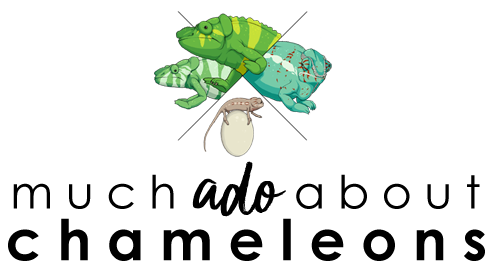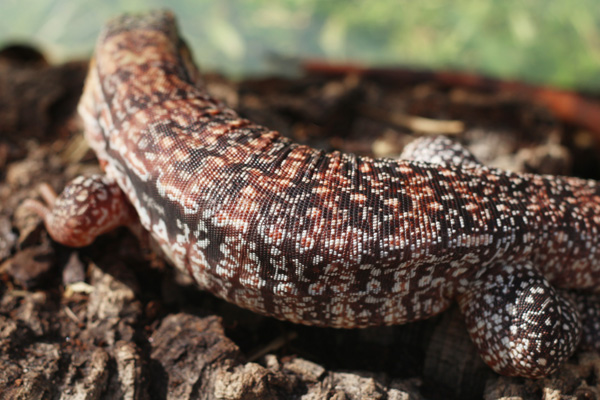This blog will document my quest to finally keep a Meller's chameleon and what is involved in treating a chameleon for several medical issues. So it will double as a guide to how to apply medications and a log of her treatment. It will be updated periodically.
 |
| My new female. She has lost her rostral (nose) horn. |
My goal for several years now has been to have a Meller's chameleon (T. mellerii), and to keep acquiring more individuals until I have a colony of them in a room to themselves. Meller's are amonst the 3 largest species of chameleon in the world, with the Parson's chameleon (C. parsonii) being the largest of the three by simply being the heaviest (about 8-900 grams. Compare that to the average weight of a Panther, which is about 150-200 grams). However, Meller's aren't very common in this country, so the individuals you typically find are wild caught from Tanzania or Mozambique and arrive in such poor condition that they don't survive very long. And when captive bred babies are available they usually sell incredibly fast, so it is hard to find any that haven't been reserved for months. But they are huge, beautiful, and typically communal so it was my dream to finally move up to this species.
Acquiring A Meller's Chameleon
My quest to own a Meller's seriously is on it's third year, with my two previous attempts ending in failure My first ever purchase was a captive born baby about 5 weeks old who was bred and sold to me by a friend in Chicago, but unfortunately the poor thing developed a prolapse on the 14th day and passed away. Being so small, there was nothing to do to save him. The second attempt was more than a year and a half later, when I was alerted to a group of WC adults that were coming into the country, and I quickly snatched up a perfect adult. He was in excellent physical condition, with even his rostral horn intact. However, he very quickly deteriorated from organ failure (due to the conditions in which they are kept during the weeks it takes to import them) and he passed away about 7 days later.
 |
| The female basking. She's very long! |
After that devastating loss I was contacted by a friend who knew of someone who wanted to rehome her CB adult female Meller's. We drove to pick her up and came back with a gorgeous, 5-year-old teal-green girl weighing in at 430 grams, almost a full pound.
The Work Begins
 |
| The female sleeping in her open cage before lights-out. |
When I brought home the female it was nighttime, so I placed her on the branches of her cage, turned off the lights and let her sleep. The next two days I left her as alone as possible, going in just to see if she would eat and to make sure the misting system was working correctly. On day 3 (January 9, 2013) I caught her with one eye closed, which is never a good sign with chameleons. Her mouth also looked a little unusual. She did eventually open up the eye to eat a few roaches from me but by the afternoon she was keeping it closed again, even after long showers, so at that point I called a great chameleon vet who lives in my area and he was kind enough to do a house call. He discovered that she had the beginning of an upper respiratory infection, mild mouth rot, and possibly an infection in the eye. Since I had left her mostly alone I hadn't noticed how bad her breathing was, but once out of her cage we could very audibly hear her breathing wheeze, moan, and crackle. This was all very disappointing given that I had hopes of leaving her alone for a week or two so she could settle in, and now we were going to have to pester her for the next two weeks giving her several medications.
The following day (Januray 10, 2013) I received my prescription for Baytril and began administering the dose. I was also going to receive an ointment that would be applied along her gums to treat the mouth rot and another ointment to treat her eye. She is a very easy-going chameleon (in that she won't gape or bite) but she has a death grip and trying to pull her out to administer medicines is going to be a struggle that neither one of us is going to appreciate. But I am hoping to make it up to her by rewarding her with some time outside for natural basking.
 NOTE: Baytril is an antibiotic with a reputation for being very hard on the kidneys of chameleons. Which is why it is incredibly important to provide a lot more water than usual, because ample hydration is the only way to keep the kidneys from sustaining permanent damage. Additionally, well hydrated feeders like hornworms are a great trick too. And I've been known to inject feeders with a little water with syringes as well and hand feed them.
NOTE: Baytril is an antibiotic with a reputation for being very hard on the kidneys of chameleons. Which is why it is incredibly important to provide a lot more water than usual, because ample hydration is the only way to keep the kidneys from sustaining permanent damage. Additionally, well hydrated feeders like hornworms are a great trick too. And I've been known to inject feeders with a little water with syringes as well and hand feed them.
Administering The Medications
January 11, 2013 - A second dose of Baytril was administered. I would like to get photos of the process to help anyone else but with chameleons, the best way to administer an oral antibiotic (aside from injecting the liquid into a feeder, but this can't always be done with all medicines) is to put the tip of the syringe as far back in the mouth as possible, essentially down their throats. This is because their epiglottis (the entrance to their airways) is located on the floor of their mouth, in the middle, and their esophagus (where food travels) is the back of the throat. So if you squirt meds into their mouth when they don't have a closed epiglottis they could aspirate the medicine. What I did yesterday was offer her a large roach, and as she was shewing I snuck the syringe in through the corner of her mouth, released the medicine down her throat, removed the syringe, and she continued to chew and swallow her food. She didn't even notice! For a species that is so sensitive to stress, it's important to try to use tricks to minimize it as much as possible.
At this time I did not yet have the ointments from the pharmacy yet, so that treatment will not begin until tomorrow.
January 20, 2013 - Since my last update we have approached the end of her antibiotic treatment, with only one more dose to go, and we are approaching the 10 days she needs ointments. I will attempt to photograph or film her receiving a dose of Baytril (antibiotic) so you can get an idea of how I do it. But as far as progress up to this point, she has stopped closing her right eye as often and I think I've seen her do it once in the last few days which is a great improvement. Her mouth still looks swollen but chameleons (and Meller's in particular) seem to take a very long time to get sick and take even longer to heal, but I have been told by my vet that we should see improvement over the coming month. Her saliva is still very thick, as you can see in one photo. Usually it is a mixture of the silvadine cream for her mouth and her saliva, but it is still pretty thick still so I'm hoping to see an improvement soon. As soon as the weather warms up again I will bring her outside again so that she can reap the benefits of sunshine.
To give you an idea of how I apply the silvadine ointment to her mouth (mind you, I'm alone so I can't take a photo and hold her mouth open at the same time) I take a Q-tip, scoop up a small blob of the cream and then I slide it across her swollen gums, which usually makes her open her mouth in protest and I can wipe it around all her gumline well. If she does not open, I will pull gently on her gular (throat) skin closest to her chin and this will make her gape enough for me to get her mouth nice and coated.
After pestering her with medicines I will usually reward her with a treat. I try to apply the silvadine cream before bed, so she doesn't swallow all the medicine before it has time to work but here I applied it earlier for the sake of illustrating it. But she was rewarded with a small roach anyway, much to her joy!
February 15, 2013 - We are still in the middle of a move (we crossed the state, have been staying with friends, and will be moving into a house of our own on the 1st, hopefully) so I apologize for the lack of updates but she is still doing great. She has been living outside almost entirely and she looks great, despite having rubbed her chin on the travel cage on the way here. The wheezing is totally gone and her mouth swelling has come down significantly.
Here are a few updated photos of Guinevere. Once we move I plan on building her a huge outdoor cage and have a friend lined up for her, who is hopefully male. I think at this point we can consider her treatment over and her condition pretty much healthy. We'll see how she continues to do but I think it's safe to say that she's doing much better and that she's a happy girl.
At this time I did not yet have the ointments from the pharmacy yet, so that treatment will not begin until tomorrow.
 |
| You can see how thick saliva is when chameleons have a respiratory infection. Here is it mixed with the oral ointment, but you get the idea. |
To give you an idea of how I apply the silvadine ointment to her mouth (mind you, I'm alone so I can't take a photo and hold her mouth open at the same time) I take a Q-tip, scoop up a small blob of the cream and then I slide it across her swollen gums, which usually makes her open her mouth in protest and I can wipe it around all her gumline well. If she does not open, I will pull gently on her gular (throat) skin closest to her chin and this will make her gape enough for me to get her mouth nice and coated.
 |
| Applying the silvadine ointment to her gums. This will help treat her mouth rot/stomatitis. |
 |
| Guinevere will work the cream around her mouth a little with her tongue, which will help it be more potent around her entire mouth. It probably doesn't taste very good! |
February 15, 2013 - We are still in the middle of a move (we crossed the state, have been staying with friends, and will be moving into a house of our own on the 1st, hopefully) so I apologize for the lack of updates but she is still doing great. She has been living outside almost entirely and she looks great, despite having rubbed her chin on the travel cage on the way here. The wheezing is totally gone and her mouth swelling has come down significantly.
Here are a few updated photos of Guinevere. Once we move I plan on building her a huge outdoor cage and have a friend lined up for her, who is hopefully male. I think at this point we can consider her treatment over and her condition pretty much healthy. We'll see how she continues to do but I think it's safe to say that she's doing much better and that she's a happy girl.
The End of the Medical Log (hopefully!)

















